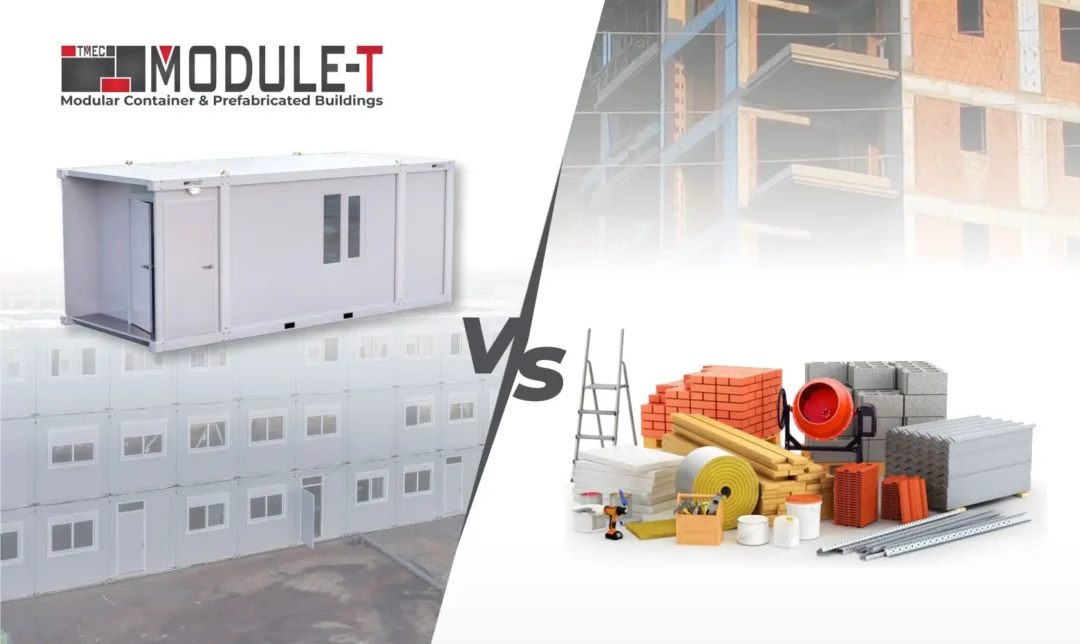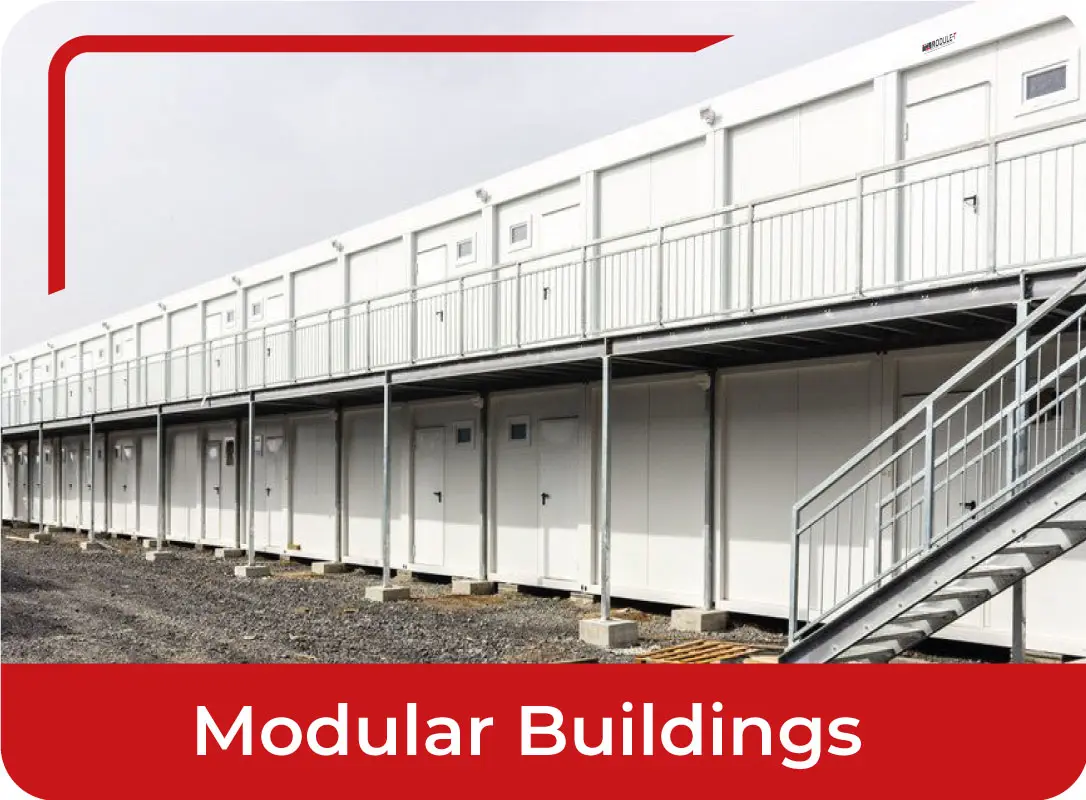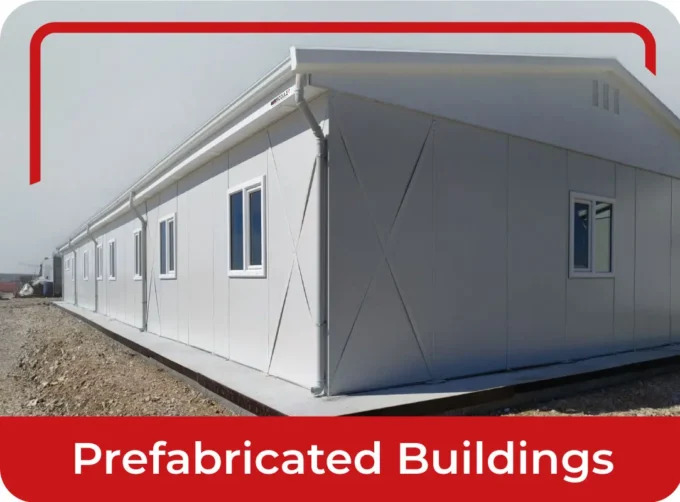Settled Building or Modular Building?
5 December 2022Many companies are now turning to modular construction as a time and cost-effective alternative to traditional builds. Module-T is often asked to explain which is better, a settled building or a modular building. To understand the answer, you first need to grasp what modular construction is and the differences between a prefabricated modular building and a conventional structure.
What Is Modular Building?
Modular building is a prefabricated construction method where the building process is conducted off-site and then delivered to a location for assembly and use. The building is made in specific sections called “modules”’ that, once joined, form a complete and fully operational structure. These modular constructions can be placed side by side, stacked, or inter-connected to create all the rooms and space you need, and you can highly customise them to suit almost any commercial or residential purpose.
Modular Building vs Traditional Building: What’s the difference?
Modular buildings are gaining popularity. The advent of energy-efficient, sustainable materials and significant technological advances have helped revamp prefabricated design and manufacturing processes, and modular constructions are now seen as far more than simply a low-budget building solution. There are several differences between the two building processes. These include:
-
Modular Buildings Can Be Temporary or Permanent
One of the main differences between modular and conventional construction is that modular buildings can be moved, whereas traditional buildings stay put in one location. Modular structures can be temporary or permanent and can be assembled, dismantled, and relocated many times, which makes them perfect for use on temporary sites such as labour camps, construction sites, military and civilian sites, mining, and industrial facilities.
-
Modular Construction Uses a Different Construction Process
Modular buildings use lean manufacturing processes and are made off-site in a highly controlled environment. Up to 90% of the build is done remotely, and the structure is then divided into sections and transported to your site for final assembly. It eliminates costly on-site weather delays and disruption and dramatically reduces time, waste, and labour costs. The sections arrive pre-painted, pre-fitted with utility connections and sockets, and customised according to your preference, meaning you can use the space quickly, and in most cases, you can have the buildings up and running in just a few hours or within a couple of days after delivery.
-
Prefabricated Buildings Can Be Highly Customised
Customising a traditional build requires a team of contractors to paint, fit and prepare the building for use, which takes considerable time and money. In contrast, a prefabricated building is designed in advance and delivered with many features already in place. Most alterations are made in the factory, and the modular structures come with windows, flooring, security features, power and technology connections, sewage lines, air conditioning, telecommunications systems, and many other components.
-
Top-Quality And Built To The Highest Standards
Modular buildings meet (and often exceed) the same standards and codes as traditional buildings. In the same manner that conventional constructions need to meet quality and safety guidelines, modular buildings also undergo regular inspections to ensure the quality and safety of the building. During traditional construction, plans are approved, and inspectors visit the location at critical points throughout the process. In contrast, these tests are streamlined and quick with off-site and modular structures due to the use of state-of-the-art technology and machinery. Inspections are made as the modules are on the assembly line, so any problems or imperfections can be quickly addressed. This process takes far less time and results in delivering a precise, high-quality product that adheres to UK, EU, and US building codes and regulations.
-
Modular Buildings Can Be Used in Remote Locations
Another significant difference is that modular builds can be shipped to remote areas where constructing a conventional building may not be possible. Prefabricated buildings can be quickly assembled in areas of extreme climatic change, such as deserts or extremely humid or wet locations. They also meet seismic and cyclonic building standards, plus extra insulation can be used, so they can even be used in areas prone to hurricanes, cyclones, and earthquakes.
-
We Produce A Wide Range of Standard Modular Buildings
A wide range of standard modular buildings is available, all of which can be customised to suit your style and purpose. Popular modular structures include office and accommodation buildings, dormitories, WC and sanitary buildings, restaurant and canteen buildings, locker rooms, shower facilities, industrial hangers, school rooms, and infirmaries. Smaller standard buildings include guard houses and security kiosks, flatpack showroom containers, booths, and shops. Please see the Module-T website for our complete product range.
-
Module Buildings Are Fast to Construct, So You Enjoy a Quick Return on Your Investment
Time is critical in any build, and the time you save by ordering a modular building is attractive as you can enjoy a quick return on your investment. Modular building means you can simultaneously lay the foundations necessary at the site whilst the building is being made in the factory, saving considerable time and up to 50% in many cases.
The Bottom Line: Which Is Better, A Settled Building or a Modular Building?
The differences between conventional and modular buildings are now apparent, so you can judge which construction is the best for you.
Factory-built modular constructions are enjoying new popularity for a good reason – they offer a high-quality, fast, and budget-friendly alternative to stick-built structures. In commercial terms, time equals money, so the time savings involved in modular construction means you enjoy a quicker return on your investment. This leaves modular buildings the most affordable and practical option for many industrial and commercial purposes, especially if you need space quickly or only plan to be at a location for a short duration.
Please get in touch with us if you want to know more about modular buildings or have any questions regarding the differences between traditional and prefabricated buildings. Order your prefabricated building from Module-T, the leading modular building company!
CONTACT US
MODULE-T
KURIS KULE D-100 GUNEY YANYOL NO: 2 / 77-78 , KARTAL/ISTANBUL - TURKEY
PREFABRIK DIS TIC VE SAN LTD STI- +90 216 441 01 77
- Send Whatsapp Message
- info@module-t.com





